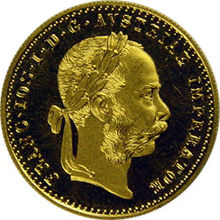
Back الذهب البندقي Arabic Dukat Azerbaijani Дукат Byelorussian Дукат BE-X-OLD Дукат Bulgarian Ducat (moneda) Catalan Dukát Czech Dëkôt CSB Дукат CV Dukat (Münze) German

The ducat (/ˈdʌkət/) coin was used as a trade coin in Europe from the later Middle Ages to the 19th century. Its most familiar version, the gold ducat or sequin containing around 3.5 grams (0.11 troy ounces) of 98.6% fine gold, originated in Venice in 1284 and gained wide international acceptance over the centuries. Similarly named silver ducatons also existed. The gold ducat circulated along with the Florentine florin and preceded the modern British pound sterling.[1]
- ^ The two concepts of money: implications for the analysis of optimal currency areas, Charles A. E. Goodhart, European Journal of Political Economy, Vol 14 (1986) page 407